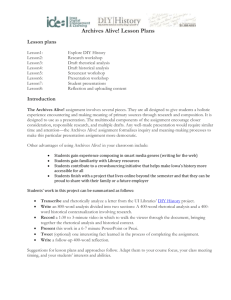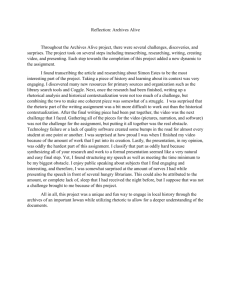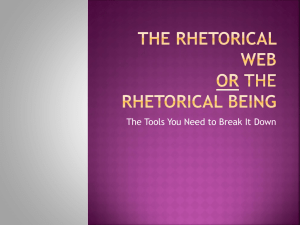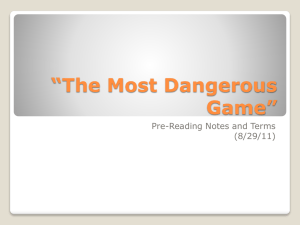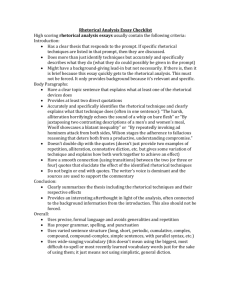Archives Alive - Lesson Plans - Ideal
advertisement
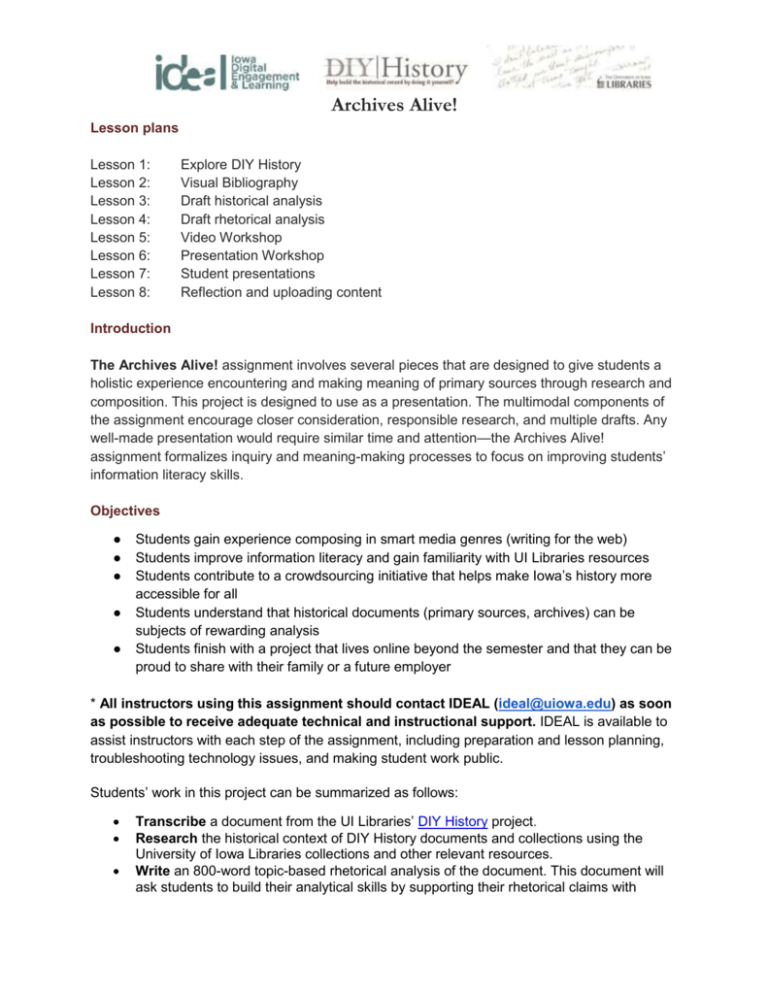
Archives Alive! Lesson plans Lesson 1: Lesson 2: Lesson 3: Lesson 4: Lesson 5: Lesson 6: Lesson 7: Lesson 8: Explore DIY History Visual Bibliography Draft historical analysis Draft rhetorical analysis Video Workshop Presentation Workshop Student presentations Reflection and uploading content Introduction The Archives Alive! assignment involves several pieces that are designed to give students a holistic experience encountering and making meaning of primary sources through research and composition. This project is designed to use as a presentation. The multimodal components of the assignment encourage closer consideration, responsible research, and multiple drafts. Any well-made presentation would require similar time and attention—the Archives Alive! assignment formalizes inquiry and meaning-making processes to focus on improving students’ information literacy skills. Objectives ● ● ● ● ● Students gain experience composing in smart media genres (writing for the web) Students improve information literacy and gain familiarity with UI Libraries resources Students contribute to a crowdsourcing initiative that helps make Iowa’s history more accessible for all Students understand that historical documents (primary sources, archives) can be subjects of rewarding analysis Students finish with a project that lives online beyond the semester and that they can be proud to share with their family or a future employer * All instructors using this assignment should contact IDEAL (ideal@uiowa.edu) as soon as possible to receive adequate technical and instructional support. IDEAL is available to assist instructors with each step of the assignment, including preparation and lesson planning, troubleshooting technology issues, and making student work public. Students’ work in this project can be summarized as follows: Transcribe a document from the UI Libraries’ DIY History project. Research the historical context of DIY History documents and collections using the University of Iowa Libraries collections and other relevant resources. Write an 800-word topic-based rhetorical analysis of the document. This document will ask students to build their analytical skills by supporting their rhetorical claims with Archives Alive! historical research. Previous semesters have asked students to consider food’s representation in different contexts, but suggested topics will change each year. Record a 1:30 to 3-minute video in which to walk the viewer through the document transcribed and the analysis comparing it to another text. Present this work in a 6-7 minute PowerPoint, Prezi, or Haiku Deck. Tweet (optional) one interesting fact learned in the process of completing the assignment. Write a follow-up 400-word reflection. Suggestions for lesson plans and approaches follow. Adapt them to your course focus, your course’s meeting times, and your students’ interests and abilities. Lesson 1: Explore DIY History 1) Tour DIY History with your students. Focus on the documents relevant to the semester or a set of documents relevant to your course’s focus. In conjunction with the University of Iowa’s 2016 theme semester Just Living, we are featuring social justice-themed collections on DIY History. View the collection here: http://diyhistory.lib.uiowa.edu/socialjustice 2) Have students describe their own experience with handwriting and reading handwritten text. 3) Look at a few student projects on ideal.uiowa.edu and at the Libraries’ model project here. 4) Give students the Archives Alive assignment. Discuss it in class or assign it as homework. 5) Homework or in-class work: Students should create a log-in to access the DIY History site Students should select the document they want to transcribe and analyze Students must type their name in the transcription box and save it as a draft— this will prevent others from transcribing the same document--but students should remove their name when their transcription is finished Though students should be able to return to their previously transcribed pages using the DIY History dashboard tool, they should also copy the URL of their document and keep it—they will need it for the rest of the assignment (suggestion: have students post the URL to your course website or e-mail you the URL so that you can compile them) Lesson 2: Visual Bibliography: Exploring Historical Context 1) Show students Coggle and explain its relevance to the assignment Archives Alive! 2) 3) 4) 5) The Coggle functions as both a visual concept map and bibliography -- a place where students can brainstorm, collect, and then organize (and re-organize) the resources they find related to their transcribed DIY History document. Students can store Coggles alongside other documents in their Google Drive (information on how to do this here), and they can take screenshot images to post to the course blog or icon site. After creating a Coggle account, students place their DIY History document title and document URL in the center of a new Coggle. Show students how to research the historical context of the document using the Collections Guide Search Tool and the DIY History Subject Guide As students transcribe their document, encourage them to notice pertinent dates, phrases, names, etc. that might help them better understand the historical context surrounding their documents. Have students explore the 'Researching Historical Context' tab on the DIY History Subject Guide page ■ Encourage students to look at the example provided from the Gilbert Haugen correspondence on women's suffrage. As students locate resources related to their document they add them to their Coggle Encourage students to develop an organizational scheme for their Coggle by changing the color of branches to represent different types of information/resources. Depending on your learning objectives, you might ask your students to organize their resource by format, author, etc. Given that students are working with primary sources and asked to refer to additional primary and secondary sources to develop an understanding of historical context, you might use this as an opportunity to discuss the differences between primary and secondary resources. ■ For example, the sample Coggle provided uses the following color-coded organizational scheme: ■ Purple = terms found within the document potentially valuable to exploring historical context ■ Yellow = secondary resources related to the document ■ Green = additional primary source documents related to the document Discuss differences between primary and secondary sources Describe as best you can how these resources were created. How did they get to the libraries? What about the process of their creation make you confident this is a good source to use for your assignment? Within their own Coggle, students distinguish primary and secondary sources by developing an organizational scheme using space and color. Homework: Students finish their transcriptions Archives Alive! Students draft their historical contextualizations and post them to the course website Lesson 3: Discussing the historical analysis draft Before this lesson, students should have completed their transcription and step 1 of their written analysis. 1) Begin with a discussion of the transcription process. A possible question to pose: What surprises, discoveries, or difficulties did students encounter in the process? 2) Students divide into groups of three and share step 1 of their written analysis (historical contextualizations) and their Coggle. How can the writer fill in details to more thoroughly or compellingly tell the story of time and place? What additional research approaches might the writer use to develop their historical contextualization? What questions are left unanswered by the contextualization? 3) Each student group nominates one person to briefly show the class their Coggle (in progress) and describe their research processes. What did they find and where? Encourage students to share helpful ideas and resources. You might ask students if they found any particularly useful databases, articles, or books, or if they found a search term particularly valuable. Also encourage students to share any challenges they faced while conducting their research. You might collaborate with a librarian in for this class session so that together you can better assist students with any additional research challenges as well as suggest additional resources and tools students might explore to help broaden or focus their research on the historical context of their document. Please contact Undergraduate Engagement Librarian, Katie Hassman (katiehassman@uiowa.edu) 4) Looking forward to when they have to draft the next portion of their analysis, lead a discussion in which students brainstorm ways in which their historical contextualization will help them form a rhetorical analysis: How do time and place shape rhetorical approaches? How do time and place reveal the goals of the author of the document and the values or commonplaces he/she was operating under? Note: this can also be completed as a brainstorming free write, or a “think, pair, share” activity 6) Reiterate the research expectations of the assignment with respect to using historical context to understand rhetorical approaches. 7) Homework: Archives Alive! Students draft the rhetorical analysis portion of their analysis. Lesson 4: Discussing the rhetorical analysis draft Before this lesson students should have drafted step 2 of their written analysis. 1) Have students “think, pair, share” On their own, students think about the rhetorical concepts they used in their draft analysis. What were the rhetorical terms they used to make sense of the document and how did they apply those terms? Students partner up (or in groups of 3) and discuss how they applied rhetorical concepts in their efforts to understand the persuasion of their documents. Every group reports to the rest of the class to describe similarities and differences they observed in the approaches to analysis. What did they learn from each other? 2) Ask students to share how they would go about accomplishing a similar rhetorical purpose to the one their document writer hoped to achieve. What media would they choose? What would be their approach? How different or similar is the medium and approach they would use to that of their document writer? Discuss the pros and cons of different media and approaches as related to the rhetorical purpose. 3) Discuss screencast videos. How is a screencast different from other videos? What is possible in a screencast that is not in a regular video? What is not possible in a screencast? How does that limit or define the rhetorical strategies of the creator? Examine examples from ideal.uiowa.edu Discuss what each video you examine does well and how it might be improved Students may also discuss in pairs or free write to consider what techniques might be best suited to showcasing their archival document. 4) Show your students where to find the “how to” resources for composing a Ken Burns effect video in various software applications. These can be found on the IDEAL AA! project page. 5) Homework: Students compose their screencast videos and begin revisions to their written analyses. Point students toward these video tutorials as resources: The Ken Burns Effect with iMovie, PhotoStory3, Adobe Premiere Lesson 5: Video workshop 1) Students discuss the discoveries and difficulties they encountered while composing videos. 2) Troubleshoot. Students who are having difficulties should work with peers who are equipped to help. Archives Alive! 3) Discuss revisions to videos, rhetorical analyses, and historical contextualization. Students should revise the collection of their work based on the assignment sheet’s requirements. Students should work to make the webpage or document where they collect their project’s artifacts visually appealing and cohesively focused. 4) Homework: Students prepare their draft presentations – 6-8 minute presentations with slides or images Hint: teach students to avoid using words on slides and instead to use images paired with a handful of words only if necessary 5) IDEAL will create a folder for your course in Dropbox.com. ***You must be in contact with IDEAL so that they are aware you are using this assignment. You will share the link with your students, and they will upload their video project there. You and students can use that Dropbox folder to play video content. Students have the option of placing their projects on the IDEAL website, where they will be featured alongside other responses to the assignment. Direct students to the project release form link on the Archives Alive! project page and let them know they must submit the form to have their work displayed publicly N.B.: you may not require or offer incentives (such as extra credit) for uploading projects to the IDEAL site. Students must opt in. You may tell students that including their project on the website will allow them to easily share it with others, will create an impressive showcase for their hard work, and will give them an online publication. Lesson 6: Presentation workshop 1) In groups of three, students run through their whole presentations with slides. 2) Peers respond with constructive feedback for revision. Consider providing a worksheet with questions and blank space for students to record commentary on each other’s presentation. Lesson 7: Student presentations 1) Students deliver presentations during class time. This may take more than one class meeting. 2) If at all possible, hold presentations in a public venue such as the Library Learning Commons. To reserve a space for presentations in the Learning Commons, write to the Learning Commons Coordinator, Brittney Thomas, at Brittney-Thomas@uiowa.edu. Let Archives Alive! her know that you want to reserve an open area for class presentations. Give her the dates and times and number of students. Also describe any special considerations. 3) You may want to require students in the audience to pose questions or hold discussion following each presentation, or, if time is dear, you can limit discussion to one question as the next student presenter sets up. Lesson 8: Reflection and uploading content 1) Assign the short written reflection. Have students focus on their learning as related to the objectives you think are most important in the assignment. 2) Students have the option of placing their projects on the IDEAL website, where they will be featured alongside other responses to the assignment. To encourage this, you can set aside class time for uploading content. ***Only instructors who have notified IDEAL they are using the project, which ensures they have a profile and an assigned area for uploads, will be able to feature their students’ work on the IDEAL website. Only students who submitted a release form with IDEAL will be able to upload. IDEAL will have sent those students a link to their video file on the Rhetoric Department’s YouTube channel, and they will use that link in the process of uploading content. Discuss the process of uploading projects. A student guide for uploading projects is posted on the IDEAL Archives Alive! project page. N.B.: you may not require or offer incentives (such as extra credit) for uploading projects to the IDEAL site. Students must opt in. If students opt to publicly show their work at this stage, direct them to the project release form link on the Archives Alive! project page You may tell students that including their project on the website will allow them to easily share it with others, will create an impressive showcase for their hard work, and will give them an online publication. Creative Commons Licensing This assignment is licensed under a Creative Commons Attribution 3.0 License. Anyone in the world is free to read, download, adapt, change, translate, and share it with others. The only condition is that you attribute the assignment to Iowa Digital Engagement and Learning (IDEAL.uiowa.edu): give appropriate credit, provide a link to the license, and indicate if changes were made. You may do so in any reasonable manner, but not in any way that suggests the licensor endorses you or your use. For more information on copyright click here
